The Oneida Tribe of Indians of Wisconsin
Basic Information from a Friend
This is my unofficial effort to provide basic information about the Oneida Nation of Wisconsin (you can use either Oneida-nsn.gov/ or OneidaNation.org, a Native American group near Appleton, Wisconsin. I'm white (with a tiny but proud drop of Mohawk blood), but have been very impressed with members of the Oneida Tribe in Wisconsin that I know personally, so I offer this page in tribute. As with the Oneida there is much to learn about Native American Tribes that lived in Wisconsin and the northeastern United States.
Guide to this page:
- Photos of Oneida Indian dancers, 2009
- Scenes from the Oneida Indian Spring Pow Wow, April 9, 2005
- Introduction to the Oneida Tribe
- Chronology of the Oneida Tribe in Wisconsin
- Oneida Notebooks Discovered: Like A "Dead Sea Scrolls" Treasure for the Tribe!
- Gambling Controversy Looms over Oneida
- 2009 Update: Oneida Tribal Lands
- Remembering Polly Cooper
- Related Web Sites
- Note on terminology
Photos of Oneida Indian Dancers Performing at Bay Beach Park, Green Bay, 2009
Oneida and Menominee Indian dancers performed for a local labor union at a gathering in Green Bay's Bay Bay Park in 2009. My family was delighted with the majestic dancing. My young granddaughter liked it also. Just a wonderful public performance. Here are a few of my photos from the event.
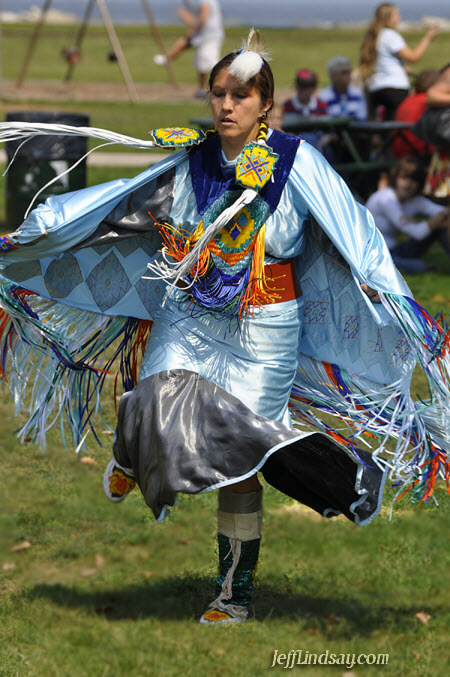
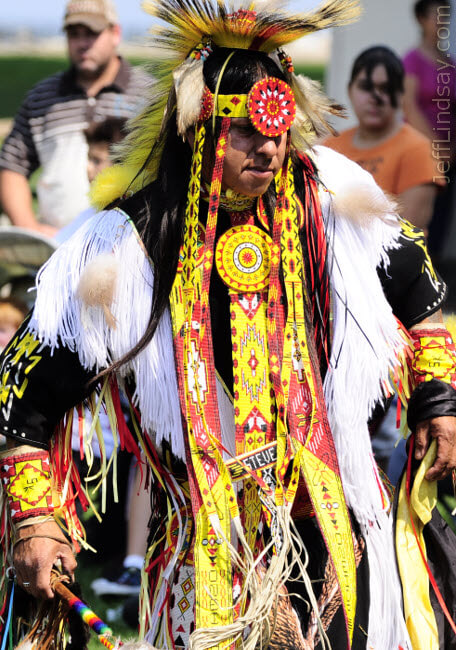
An Oneida man and an Oneida woman dancing.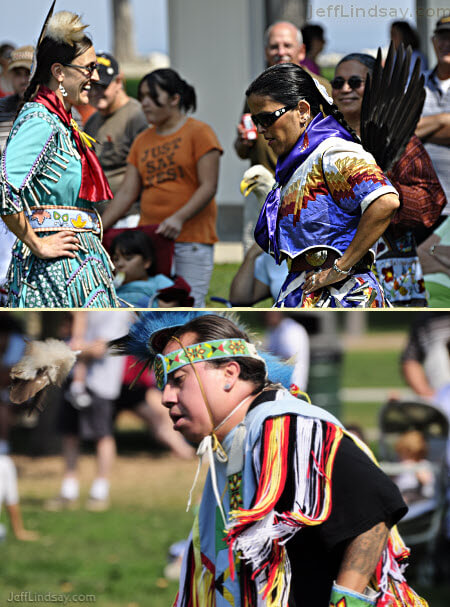
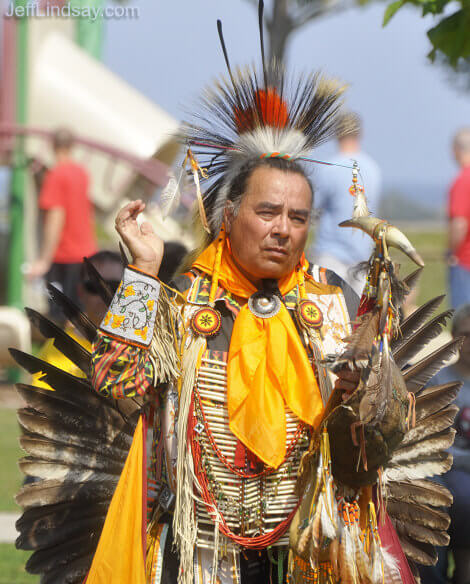
More Oneida dancers.
Scenes from the Oneida Spring Pow Wow, April 9, 2005 [index]
Here are some photos from the Spring 2005 Pow Wow sponsored by the Oneida Tribe of Wisconsin held at the University of Wisconsin, Green Bay. Photographs are copyright 2005, Jeff Lindsay.
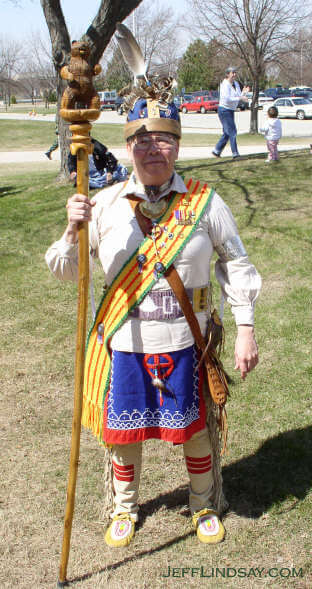 | 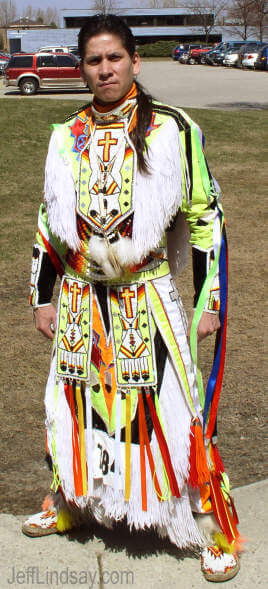 |
| Proud member of the Bear Clan at the Oneida Spring Pow Wow, April 9, 2005, University of Wisconsin, Green Bay | A talented and proud Native American dancer at the Oneida Spring Pow Wow. |
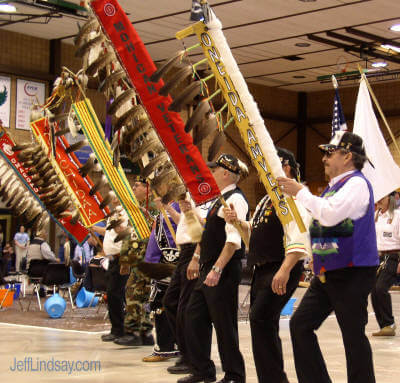 | 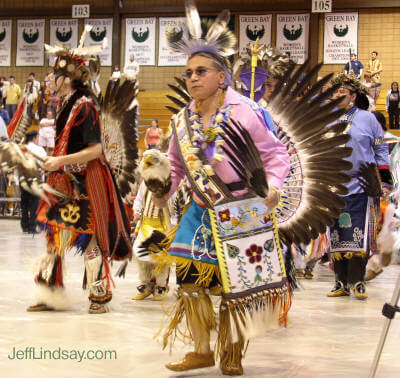 |
| Veterans leading the dramatic entrance of the color guard and dancers. | His name is Bear Who Dances for the People, an amazing Oneida man of great peace and purpose. His naming by an Elder of the tribe was a significant and powerful moment for him as well as the Elder. |
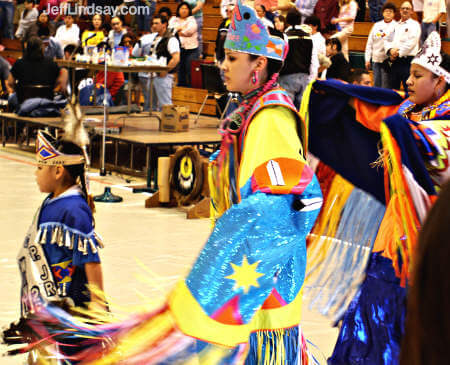 | 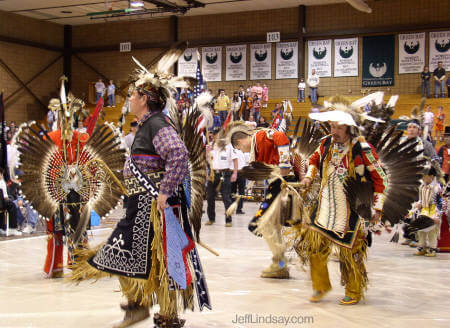 |
| The Princess of the Pow Wow and two other girls dancing. | More of the amazing dancers at the Pow Wow. |
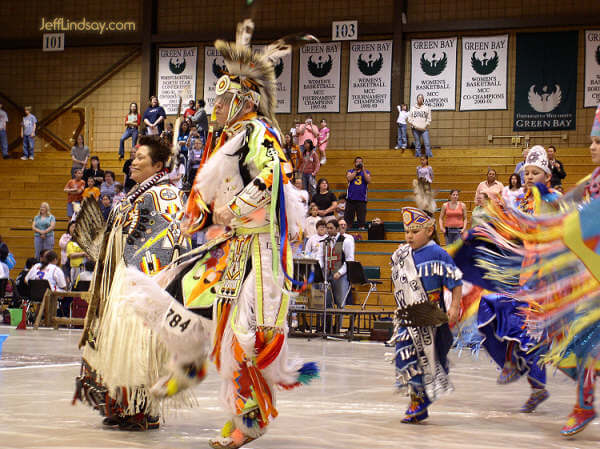 Even more dancers. |
Introduction to the Oneida Tribe [index]
Although their original homelands were in the area of New York, the Oneida Nation is scattered today in several parts of North America (Wisconsin, New York, and Canada). The Oneida Indian Reservation in Wisconsin (a few miles north of Appleton and southwest of Green Bay) is where many members of the Oneida Nation reside. There are over 12,000 registered tribal members in Wisconsin, about 1,700 in Canada and perhaps less than 500 in New York. Nearly 2500 live directly on the reservation, and an additional 2500 live in adjacent Brown and Outagamie counties.
The Oneida Nation is governed by a Business Committee of nine members (four officers, five council members).
Those visiting the Appleton/Green Bay area should be sure to visit the Oneida Nation Museum near the intersection of Highway E and Highway EE (W 892 EE Road, DePere, WI 54115) in the heart of the Oneida Reservation (call them at 920-869-2768). This museum features historical and cultural information, with beautiful examples of Oneida crafts and art (I especially love the colorful creations with dyed porcupine quills). There is also an Oneida long house behind the museum, plus a great nature trail.
The Oneida (both in New York and Wisconsin) are one of the 6 Iroquois nations. Their tribal areas originally extended around Lake Oneida, New York and south to the Susquehanna River. The Oneida and the Tuscarora (adopted as the 6th Iroquois tribe) remained loyal to the American Colonists during the Revolutionary War. The Oneida Nation provided crucial food and supplies to the Revolutionary Army at Valley Forge, and some Oneidas fought along with the colonists against Great Britain. According to Loretta Metoxen, Tribal Vice Chairman of the Oneida Nation (see my note on terminology) in Wisconsin, as quoted in The Post-Crescent (Nov. 16, 1995, p. B-1), "The Oneida played crucial roles in several pivotal battles during the Revolutionary War. Oneidas have been veterans of every war up to and including Desert Storm."
The Oneidas had to take refuge within American settlements when other Iroquois tribes sided with the British (Funk and Wagnalls New Encyclopedia, Vol. 19, p. 371, 1990).
The Iroquois Constitution, or "Law of Peace," influenced Benjamin Franklin's thinking and through him, influenced the development of the United States Constitution. One important feature of the Law of Peace that was adopted in the U.S. Constitution is the process of impeaching leaders.
The contributions of the Oneida in early U.S. history have been largely ignored in history books, possibly because much of the history of the Revolutionary War was compiled in the 1830s at a time when the Indian nations were being "resettled" under the barbaric Indian Removal Act. Giving them credit for help with the Revolutionary War was not politically expedient. It is time to recognize the important historical contribbutions of the Oneida people and other Native Americans.
The Oneida (or Onyota'a:ka) are the "People of the Standing Stone." Back when in New York, they would move their villages every 10-20 years when hunting became scarce and the soil depleted. According to oral tradition, a large stone, too big for even 20 men to move, appeared outside the village gates after each move. The Oneidas concluded that the stone followed them and protected them. The rock became the national symbol of the Oneida, or People of the Standing Stone. The Oneida Reservation in Lake Oneida, New York, still has a large stone said to be the original standing rock.
The Oneida Nation has a long reputation for hospitality and a love of peace. Historically, strangers passing through Oneida lands, regardless of race, would be treated kindly and provided food and shelter. The Oneida Tribe of Wisconsin is also exemplary for the way they care for their own, especially their elderly. They have a well-run nursing home and many compassionate programs and services to ensure that their elderly are cared for. I also see great examples of strong extended families and regular one-on-one service and caring in the Oneida community.
Like many other Indian tribes, the Oneida Indians once controlled large tracts of land that have been taken from them. In New York during the early 1800s, land speculators forced the Oneida to sell large sections of their lands. They controlled six million acres at the time of the American Revolution, but by 1839 it had become a mere 4500 acres. An article on Oneida history from Milwaukee Public Museum describes the events that took them to Wisconsin:
In 1816, Eleazar Williams, an Episcopalian Mohawk preacher who spoke fluent Oneida, arrived among the Oneida. At the time two groups of Oneida existed: the Christian Party and Pagan Party. Williams reinvigorated members of the Oneida Christian Party, who had converted to Christianity during the 1700s. Williams also converted members of the Oneida Pagan Party, which clung to Iroquois traditional religion. The Pagan Party became known as the Second Christian Party. Despite their common Christian faith, differences still remained between the two and the tribe was not united.
Treaties in Wisconsin
Williams and Jedidiah Morse, a White missionary, believed the Oneida and the other Iroquois nations would continue to suffer White encroachment in New York. They launched a plan--approved by the federal government--to relocate all New York Indians the Green Bay, Wisconsin area. Many Stockbridge and Brothertown favored removal westward as well. A delegation led by Eleazar Williams arrived in Green Bay in 1821 and negotiated with the Menominee and Ho-chunk for about 860,000 acres. The next year, another delegation negotiated a second treaty for an additional 6.72 million acres on the western shore of Lake Michigan.
The Menominee and Ho-chunk tribes, however, argued that these treaties had been done without their chiefs being present and that interpreters had not accurately handled the negotiations. This began an 8-year-long dispute over lands in Wisconsin that resulted in much smaller grants of land to the Oneida Tribe. Millions of acress became 500,000 and then finally 65,400 acres - the acreage of the current Oneida Reservation, most of which is now private land no longer owned by the tribe.
Interestingly, Eleazer Williams was said to be the long lost Dauphin of France (among many others). The group of Oneida Indians he brought to Wisconsin had 448 people, all Christian from the "First Christian Party." They settled areas that would become known as Grand Chute and Kaukauna near Appleton, Wisconsin.
The next year, 206 Oneida Indians, primarily Methodists known as the Second Christian Party settled the area. Other small groups followed, including 44 non-Christians in 1841 (the "Pagan Party").
Oneida Indians in Wisconsin who later became members of The Church of Jesus Christ of Latter-day Saints ("Mormons") would form a core of strength for new Latter-day Saint congregations in northeastern Wisconsin. Oneida Latter-day Saints would help establish and strengthen congregations in Appleton and Green Bay. A new LDS chapel for members in the Oneida area was built in 1994 and now hosts a flourishing congregation of Native Americans and whites. I was part of a committee that worked with Oneida members in making plans for the new chapel and an Oneida congregation, at a time when Oneida members were part of one of the Green Bay congregations. The strength of the modern Oneida congregation has been wonderful to see.
Here is some related background information, excerpted from a page by the Environmental Protection Agency on the Oneida Tribe of Wisconsin:
The On yote a ka (Oneida Tribe of Indians of Wisconsin) is a member of the Iroquois Confederacy, indigenous to central New York state. The Oneida Tribe is a federally recognized Indian Nation of 14,533 members, one-third of whom live on or near the 65,000 acre semi-rural reservation. The Oneida Indian Reservation was established by the Oneida Treaty of 1838 (7 Stat. 566, Feb. 3, 1838).
The Oneida Reservation is located southwest of the city of Green Bay and west of the Fox River. It straddles the boundary of Brown and Outagamie Counties and includes all or portions of the City of Green Bay, Villages of Ashwaubenon and Howard, and the Towns of Hobart, Oneida, and Pittsfield. The Oneida Nation and Oneida Tribal members own nearly 22% of the total land acreage within the Oneida Reservation. This percentage will increase as the Oneida Tribe implements a policy of reacquiring title to all land within the boundaries of the Reservation set by the 1838 Treaty. . . .
The Oneida Nation is one of the largest employers in northeastern Wisconsin with over 3,000 employees, including 975 people in tribal government. The Tribe manages over 16 million dollars in federal and private grant monies and a wide range of programs, including those authorized by the Indian Self-Determination and Education Assistance Act.
The Oneida Nation is governed by the General Tribal Council, consisting of all enrolled members over 21 years of age. Most governmental functions are delegated to an elected nine member Business Committee, which has responsibility for legislation and administration of tribal affairs. The legislative function of the tribal government is the Legislative Operating Committee, consisting of five members of the Oneida Business Committee. The judicial function of the tribal government is handled by several original hearing bodies, including the Personnel Commission and Environmental Resource Board. Appeals are taken to an elected nine member Appeals Commission, which has final decision-making authority over disputes.
Chronology of the Oneida Tribe in Wisconsin [index]
(Based on an article by Steve Wideman in The Post-Crescent, Sept. 24, 1995)
Before 1776
The Oneida Nation controlled millions of acres of land in the eastern United States. Land was lost as the colonists moved in. During the Revolutionary War, many villages were destroyed by the British and apparently by colonists as well.
1788
The Oneida signed a treaty giving up 5.3 million acres of land in the state of New York. This land was directly in the planned route for the Erie Canal.
1821
Representatives of the Iroquois Confederacy negotiated with the Winnebago and Menominee Nations for land west of the Great Lakes. The Oneida then paid the U.S. government roughly $25,000 for about 5 million acres in what would become Wisconsin and many Oneida Nation members relocated to that area. The Oneida agreed with the Menominee and Winnebago nations that all three nations could use the land.
1822
A treaty of Sept. 23, 1822 reduced the Oneida's land in Wisconsin to 3.9 million acres.
1838
The federal government established a reservation of 65,430 acres in the Treaty of Buffalo Creek. The Town of Oneida and the Town of Hobart are formed.
1887
The Indian Allotment Act (Dawes Act) was passed in Congress. It allocated land to individual tribal members rather than to the tribe itself. What should have been 65,000 acres to the tribe became 100 acres each to 650 people.
1924
Nearly all of the original reservation land in Wisconsin had been taken from tribal members by mostly unethical means.
1934
The federal Indian Reorganization Act gave Indian tribes quasi-sovereign status.
1937
The federal government bought 1,270 acres of land in the original reservation area and placed it in trust to the Oneida.
1983
Outagamie and Brown Counties (and the towns of Oneida and Hobart) filed a lawsuit claiming that the Oneida reservation ceased to exist when most of the original land was purchased by outsiders (Anglos). The suit sought to abolish the reservation boundaries and remove tribal control over reservation lands. The suit would be dismissed in 1990, but this fostered the current Oneida effort to buy back reservation land in order to protect the sovereignty of the tribe.
1989
The Oneida Tribe owned 2,473 acres with 1,690 locked in tax-free trust.
Today
The Tribe in Wisconsin now owns over 4,600 acres, with 2,740 acres in trust. This is still only a small fraction of the original reservation land.
After being largely ignored for years, the Oneida Tribe is receiving a lot of attention as the success of its casino and gambling operations have brought financial clout to the tribe. In addition, gambling money helps ensure that each tribal member can receive a college education if he or she desires it.
Photo of Some Oneida Indians in Oneida, Wisconsin, Around 1906
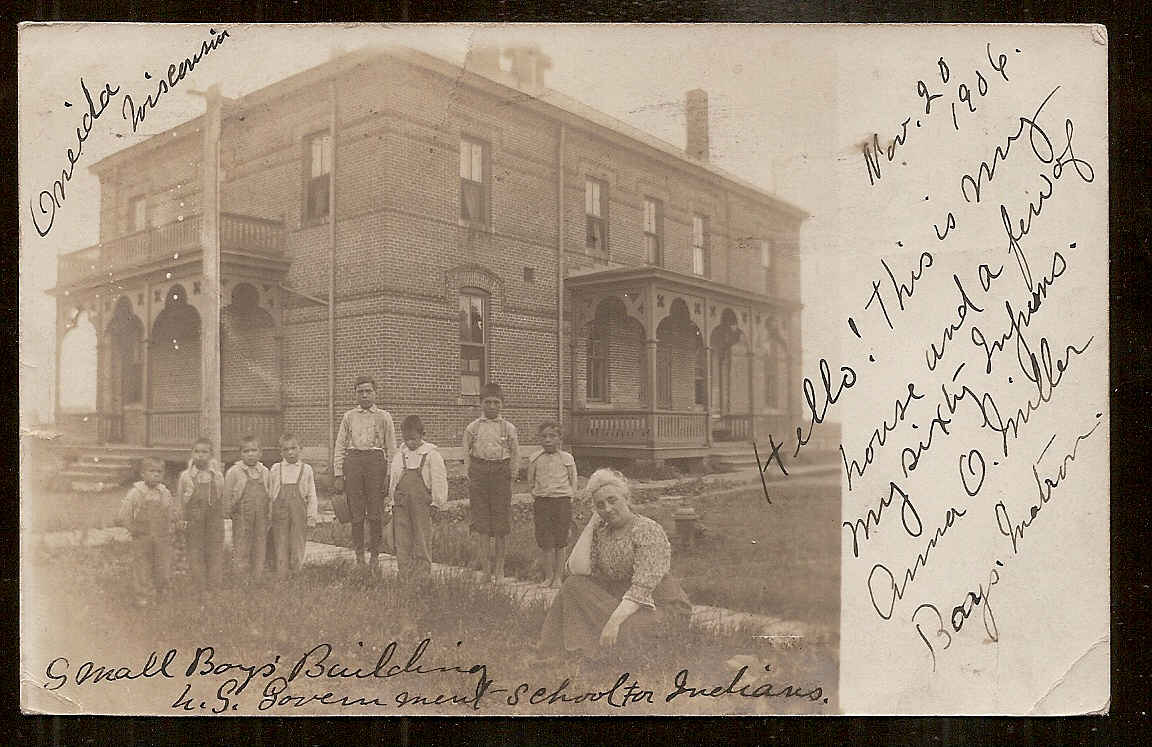
This historic postcard is of the "Small Boys Building U.S. Government School for Indians" and a note on the postcard reads, "This is my house and a few of my sixty Indians. Anna O. Miller, Boys Matron. 1906." The photo of the card was kindly sent to me by David Samerott of David Semsrott Stamps & Vintage Collectibles, Ephemera, 11235 Manchester Rd, Kirkwood, MO. 63122 (St. Louis Co. Mo.). Thanks, David!
Oneida Notebooks Discovered: Like A "Dead Sea Scrolls" Treasure for the Tribe!
"The History of Oneida WPA Stories" by Susan G. Daniels provides fascinating information about a treasure for the Oneida people that was recently discovered. In 1998, a collection of 167 notebooks was discovered in a storage room at the University of Wisconsin in Madison. These notebooks contain hundreds of stories from Oneida Indian Tribe members around the country and were prepared as part of a special program during the New Deal. The stories have been compiled on a 13-CD collection by Susan Daniels of Shawano, Wisconsin, who can be reached by email at sdaniels1 at tds.net. Here is an excerpt of her essay on the topic:
Another interesting program that impacted our community was the Federal Writers Project. Floyd Lounsbury and Morris Swadesh were instrumental in directing and overseeing the Works Progress Administration or WPA stores that were gathered in the Oneida community during 1939. Over 800 short stories were collected along with 167 notebooks. In the short stories, the thirteen original interviewers, all Oneida, included Oscar Archiquette, Ida Blackhawk, Tillie Baird, Guy Elm, John Skenandore, Walter Skenandore, Lewis Webster, David Skenandore, Dennison Hill, Lafront King, Andrew Beechtree, Stadler King and Alex Metoxen, stories were written in Oneida and later translated into the English language. These works have never been published but three full sets were maintained. One remained in the Oneida community, one with Floyd Lounsbury and the third was housed at the University of Wisconsin, Madison. These stories contain a rich and unlimited source of historical information for anyone interested in critically analyzing its contents.
The main subjects include stories on Alcohol, Animals, Band, Events, Food, Government, Health, History, Hunting, Names, Oneidas, Oneida Works, Places, Religion, Schools, Stories "About" or "Told By" or "Told To", the Supernatural, Tribes and War. Within each of these categories are hundreds of stories on specific events, times, places and people.
Many community members were interviewed, sharing accounts of historical events that affected our people. Such stories include information about community meetings held to discuss the adoption of our IRA government, the building of Parish Hall, good fishing spots, planting, harvesting, maple syrup, marriage customs and general lessons about life. Some of the people interviewed include Louisa Christjohn, Antone Swamp, Nelson Cornelius, Chauncey Baird, Elizabeth Webster and Mary Parkhurst, to name a few.
During the 1970s Maria Hinton and Amos Christjohn brought these stories back to life. Efforts were being made in the community to relearn the Oneida language, and one attempt included publishing these stories in the KaliWisaks in the Oneida language with an English translation. Together, Maria and Amos transcribed these stories from tapes into a written format and then translated them into English. Small booklets were published which included several of the WPA stories, again in Oneida and English. Mary Lemieux Prescott was commissioned to illustrate the stories in order to bring life to the characters portrayed within the tales. Maria and Amos continued their work and eventually published an Oneida dictionary. Maria continued on with the WPA stories and has produced A Collection of Oneida Stories.
Today, the WPA collection is again receiving attention. A tremendous effort has been made to index the stories in a more detailed format and to create collections based on the original thirteen interviewers. These stories hold a wealth of information and may provide the resources needed for a valuable genealogy research project for our Oneida students. We are fortunate to have this collection available in our community.
Gambling Controversy Looms over Oneida [index]
While the introduction of gambling on the reservation has been hailed as a great economic blessing to the Tribe, I have had comments from several Oneida members indicating that legalized gambling may have been an even greater curse. With millions of dollars now being controlled by leaders of the Tribe, there are many opportunities for corruption, abuse, and contention. Some members wonder where all the money is going, while others are dismayed at the divisiveness that has been created. Apparently there have been some significant intra-tribal conflicts over use of the money. (In my opinion, any source of funds that relies on human greed and stupidity is not going to strengthen its recipients.) Here is an example of one comment:
I have seen the Casino literally divide the clans and set friends and relatives against each other in bitter never-ending battles over money. The fact of the matter is that there is very little distribution of the money to the people. It does not trickle down to the little people. Furthermore the Casino created more jobs for white people than it did for Oneidas.
Legalized gambling on the Oneida reservation, which has meant millions of dollars for the Oneida Tribe, received the support of the State because of the tax money it is supposed to bring to Wisconsin State coffers. There's just one problem: the Oneida casino isn't paying taxes on their take. Nearly $5 million are still owed, according to the State. A dispute is underway. Stay tuned....
Oneida Tribal Lands
In Feb. 2009, there was a court ruling that may change the status of many lands under some degree of tribal control. As reported in the Green Bay Press Gazette (Feb. 28, 2009), a Supreme Court ruling limits the federal government's authority to hold land in trust for Native American tribes. Many tribes have been able to put lands out of state control by putting them in trust, so the decision could affect tribal control in many cases. However, the ruling applies to reservation lands recognized since 1934, whereas the Wisconsin reservation of the Oneida Indian Tribe was established in an 1838 treaty and merely reorganized after 1934. Thus, the ruling may not have any impact on the Wisconsin tribe, though we need more time to know that for sure. The Tribe has a little over 1/3 of its land, 2740 acres, in trust.
For more information on the sovereignty and lands of the Oneida Tribe of Wisconsin, see the Oneida tribal government website at Oneida-nsn.gov.
Oneida Language Initiative [index]
"Oneida Language Initiative Under Way," an article in the Green Bay Press-Gazette from April 14, 2004 reports that the Oneida Tribe has signed a charter detailing ways to preserve the Oneida language, which will become the official language of the Tribe. "The goal is to have language as a part of our day-to-day life in Oneida," said Caold Cornelius, a manager of the Oneida Cultural Heritage Department. "We only heard the language when we got around grandpa and grandma. Now you're going to hear it throughout the course of your day."
The Oneida Language Charter Team, according to the news story, is working to help the tribe's 15,000 members become fluent in the Oneida language.
Personally, I am happy to see efforts being made to preserve this language. It pains me to see that other Native American languages have become extinct in the past few decades, often with very little information left about the former language. Each language is a precious record and contains information of value to scholars in several fields trying to piece together the relationships between tribes, the history of this continent, and the origins of its peoples. The more we can preserve knowledge about indigenous languages, the more we all benefit. Of course, the proud Oneida people will be the primary beneficiaries from the efforts made to preserve their ancestral language.
Remembering Polly Cooper [index]
Previously reported plans on a movie about Polly Cooper, a famous Oneida woman, have been scrapped. Very sad. Hollywood moguls, take note: America really needs a movie about the role the Oneida Indian tribe played in the Revolutionary War. Such a movie could look through the eyes of Polly Cobus (Polly Cooper), an Oneida woman who was a cook that helped save George Washington's starving army at Valley Forge. More about the Polly Cooper story is available in an online posting by Dan Umstead and in an edition of the Indian Time Newspaper. Also see "Polly Cooper: Oneida Heroine (archived)," a Feb. 2009 article from OneidaIndianNation.com. You can also see the current version of "Polly Cooper: Oneida Heroine."
Polly was among a group of Oneida Indians who walked hundreds of miles, risking their lives, to bring food to George Washington's desperate army at Valley Forge. Among the items brought were over 600 bushels of corn. The soldiers were so famished that they wanted to eat the dry corn raw, which could have been harmful (it swells). The Oneida had to stop the Colonists to protect them. Polly Cooper stayed with them to show them how to cook and prepare the corn. George Washington later recognized the contribution of the Oneida to American freedom by signing a unique treaty with the Oneida Nation to preserve Oneida land in New York. Polly refused payment for her work, but was later taken to Philadelphia by Martha Washington for Thanksgiving as a token of appreciation.
Todd Larkin, president of Samurai Ltd., a firm that was exploring the possibility of a movie about Polly Cooper, notes that the Oneida oral tradition of their involvement in the war has been heavily corroborated by newspaper articles and military correspondence from the Revolutionary War (The Post-Crescent, Nov. 16, 1995, p. B-3). But this primary evidence was downplayed or ignored by later historians.
I once had the pleasure of meeting Todd Larkin and learned that he had been studying Oneida history and promoting Oneida genealogical research for a long time. As part of his past efforts, thousands of documents were reviewed that tell the story of Oneida Nation members over the years. He might be a good resource if any company finally does take on the task of telling the amazing story of Polly Cooper and the Oneida Indians during the time of the Revolutionary War.
Oneida Silverware?
I have been asked in the Oneida Indians were great knife makers whose workmanship led to the Oneida brand silverware that is very popular today. Oneida silverware is not derived from the Oneida Tribe. It id produced by a company that is a vestige of the Oneida Community, a utopian society formed in Oneida, New York in 1848 by people of European descent. That community floundered, though Oneida silverware is still produced.
Related Web Sites [index]
- The Oneida Nation of Wisconsin: OneidaNation.org and also Oneida-nsn.gov/
- The official Web site for the Wisconsin Oneida tribe. An especially useful page at this site deals with Oneida History. Also see the Homelands History page.
- Wikiepedia: Oneida Indian Nation of Wisconsin - not much there yet. Feel free to add!
- The Oneida Nation of New York
- The official Web site of the Oneida Nation of New York. This site provides a rich and well done source of information. You can hear audio samples of the Oneida language, learn about the history and the legends of the tribe, see text of treaties, and more. (As of July 2003, this site appears to be down. Stay tuned...
- Oneida Indian Fact Sheet
- Milwaukee Public Museum: Oneida History
- Good basic information on the Tribe.
- Bibliography for the Oneida Indians
- A large page from the library at the University of Wisconsin - Green Bay.
- Native Americans: Web Resources
- A large index to web sites about Native Americans. Among other things, you can see a list of all federally-recognized tribes with links to official web pages for them, if available. That's how I found the site above for the Oneida Nation of New York (my favorite web searcher couldn't find it).
- Mohawk Language Resources
- I am proud to be part Mohawk - although it's only 1 part in 512.
-
The Constitution of the Iroquois Nations (from Constitution.org, but archived at Archive.org)
- The Great Binding Law, Gayanashagowa, of the Iroquois nations, including the Oneida Nation, offers a wise system of checks and balances that influenced some of the leaders who wrote the United States Constitution.
- Oneida Nation Museum
- That's the official site. Call them at 920-869-2768.
- Native American Technology
- A new site where fascinating Native American technology and craftsmanship is shown. The focus is on Eastern Woodlands tribes. (Some of what you'll see resembles Oneida works.) The site is the project of Tara Prindle of the Department of Anthropology at the University of Connecticut.
- The Oneida Indians in the Age of Allotment, 1860-1920 by Laurence M. Hauptman, L. Gordon McLester, University of Oklahoma Press, 2006. A valuable book on the history of the Oneidas, part of a 3-volume collection.
- "Oneida Elders Reflect on Their Board School Experiences" - Chapter 9 of The Oneida Indians in the Age of Allotment, 1860-1920.
- Oneida Lives: Long-Lost Voices of the Wisconsin Oneidas edited by Herbert S. Lewis and L. Gordon McLester, University of Nebraska Press, 2005. Valuable book exploring the stories of individuals from the Wisconsin Tribe.
- Haudenosaunee Links
- Index to Lindsay's pages
- Jeff Lindsay's home page
Note on terminology [index]
The Oneida Nation in New York prefers that the term "Oneida Nation" only be used to refer to the Oneida living on the ancestral lands of the Oneidas in New York, and their Internet coordinator has informed me of this. On the other hand, the Oneidas in Wisconsin also refer to themselves as members of the Oneida Nation, and given the numerical majority in Wisconsin, I feel their use of the term is fair. The press in Wisconsin also regularly describes the Oneida here as The Oneida Nation, and while the press is often incorrect, I have heard no complaints about their use of this term. However, to be fair, I will provide the comments from the Internet coordinator of the Oneida Tribe in New York on this issue:
Dear Mr. Lindsay:
I write regarding the Oneida Indian Nation. As the Nation's Internet Coordinator, I request that you clarify your statements on the Web to avoid confusing the public about the Oneida Indian Nation and the Oneida Tribe of Indians of Wisconsin. You are identified as the webmaster of a site on the Web entitled the Oneida Indian Nation but concerning the Oneida Tribe of Indians of Wisconsin. The Oneida Indian Nation and the Wisconsin Tribe are not the same. They are separate sovereigns, with different governments and different members. The Oneida Tribe of Indians of Wisconsin is located in Wisconsin and was established under U.S. Law in 1937. The Oneida Indian Nation has existed since time immemorial in an area of what is now known as Upstate New York. I ask that you change the name and content of your piece to make clear that it is about the Wisconsin Tribe and not the Oneida Indian Nation.
(In response, I did change the title of this page and added several clarifying comments.)
Curator: Jeff Lindsay, Contact:

Last Updated: Sept. 29, 2012
URL: "https://www.jefflindsay.com/Oneida.shtml"